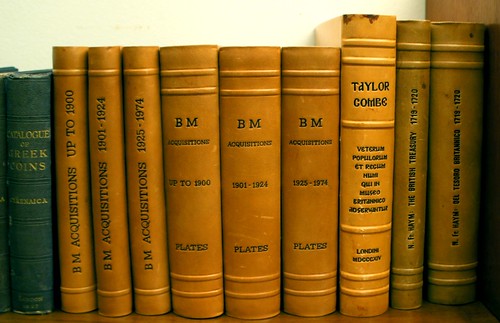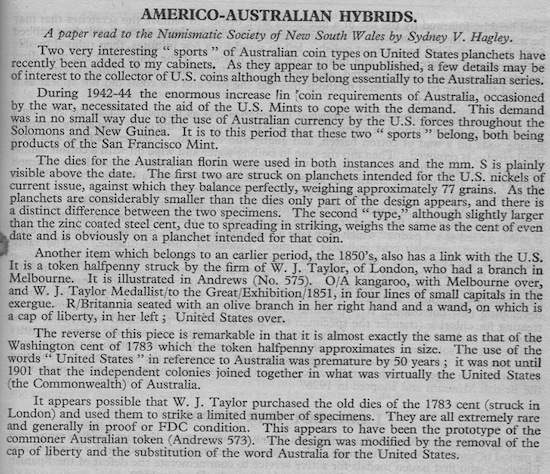The Value of Having A Numismatic Library

We recently picked up a rather large library of numismatic books from a deceased estate here in Perth - no less than 20 crates of books that had been in storage for around 30 years.
It turns out they belonged to a dealer that was active in Perth from the late 1970’s to the early 1980’s, one that it could be argued left town “prematurely”.
When I was initially faced with the prospect of sorting out this library, it wasn’t evident that there any books at all in it that had a lot of great information in them. I was feeling more dread at the work ahead of me, rather than excitement at the prospect of unearthing a productive gem within it!
Dead silverfish, dust, ratty old cardboard boxes falling apart - the smell alone put me off! It didn’t help that the books were also very disorganised, were written in foreign languages and on subjects that aren’t close to being in my main areas of interest.

That’s nothing that a strong coffee and some resolve won’t fix however, so I set about emptying all the boxes and started grouping the books together as best I could. Auction catalogues in English went in one pile, auction catalogues in foreign languages went in another, books on ancient Roman coins were in one pile, specialist books on certain foreign coins went in another.
After two or three rounds of this kind of sorting, I had them in enough different piles that would allow me to start cataloguing them. I then went through each pile one by one, and entered all of the details for each book into the spreadsheet.
Many hours of work later has left me with an extensive list of several hundred numismatic books and catalogues that have literally transformed being from a disorganised mess of stinky, dusty books to being a solid resource of numismatic information.
The task ahead is to now appraise the library - to look at what comparable titles have sold for recently at auction, what they’re advertised for by numismatic literature dealers around the world (yes, as crazy as it seems, there are businesses in the world that are solely dedicated to handling numismatic libraries such as this!), and work out what a fair price for each catalogue is.
Just before I closed the door on the temporary numismatic library the other night (the spare room at Chez Crellin), I grabbed a copy of the title closest to me to review while recovering with a glass of red wine.
The book was a bound copy of “Seaby’s Coin and Medal Bulletin” from 1947 - a combination between a direct mail catalogue and a numismatic newsletter, hugely popular and influential with collectors between 1940 and 1991.
I thought I’d flick through the 1947 edition just on the off chance there was something interesting - whether that was going to be a snippet about British colonial coins from the 1800’s, Australian Commonwealth coins or paper currency prior to Federation who knows, but I was hoping it was worth a scan regardless.
So it was a welcome surprise on page 75 that I came across an article that was topical - it covered off-metal strikes of Australian pre-decimal coins, struck in the United States during World War II.
The noted Australian numismatist, Syd Hagley, had submitted a paper for the Seaby Coin and Medal Bulletin in 1947 entitled “Americo-Australian Hybrids”. In it, Hagley states that “Two very interesting ” sports “ of Australian coin types on United States planchets have recently been added to my cabinets. As they appear to be unpublished, a few details may be of interest to the collector of U.S. coins although they belong essentially to the Australian series.”
“During 1942–44 the enormous increase in coin requirements of Australia, occasioned by the war, necessitated the aid of the U.S. Mints to cope with the demand. This demand was in no small way due to the use of Australian currency by the U.S. forces throughout the Solomons and New Guinea. It is to this period that these two ”sports“ belong, both being products of the San Francisco Mint.”
"The dies for the Australian florin were used in both instances and the {mintmark} S is plainly visible above the date. The first two are struck on planchets intended for the U.S. nickels of current issue, against which they balance perfectly, weighing approximately 77 grains.
As the planchets are considerably smaller than the dies only part of the design appears, and there is a distinct difference between the two specimens. The second “type”, although slightly larger than the zinc coated steel cent, due to spreading in striking, weighs the same as the cent of even date and is obviously on a planchet intended for that coin."

This subject - errors occurring in the production of Australian coins at US branch mints during World War II, is no doubt a specialised one, one that would cause the eyes of even most Australian coin collectors to glaze over, much less a non-collector.
To the keen student of the Commonwealth series though, this chance find definitely is interesting however. Here, we have what is possibly the earliest published reference to an error occuring in the production of an Australian coin at a foreign mint, that it was made by a numismatist of Syd Hagley’s standing makes such errors all the more interesting.
I can’t say that I relish the prospect of looking through the remainder of the 200 odd books in this library, however the thought that further little snippets of information like this might be salted within them gives me just enough strength to continue the search!